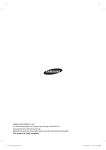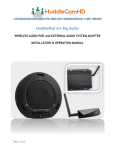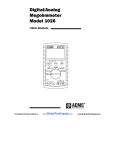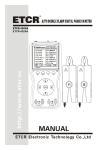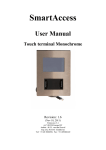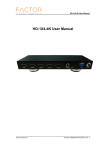Download PJ-D3 Ultra Precision Polishing Fixture Manual
Transcript
A User’s Manual For the Operation and Maintenance Of the PJ-D3 Ultra Precision Polishing Fixture Surface Technologies Incorporated 1 A User’s Manual For the Operation and Maintenance Of the PJ-D3 Ultra Precision Polishing Fixture Contents Page ______________________________________________________________________________ I. Introduction 3 II. Specification and the structure 3 1. Specifications 2. The structure diagram and components 3. Structural description III. Operations 6 1. Mounting specimens and polishing parallel surfaces 2. Polishing wedge specimens 3. Adjusting the polishing load 4. Controlling the stock removal IV. Maintenance 10 Surface Technologies Incorporated 2 I. Introduction The PJ-D3 ultra precision lapping/polishing fixture is used to hold flat specimens of widely varied geometries to be precisely lapped/polished on MTI Unipol 1202 or Unipol 1502 machine or similar machines. The key component of this fixture is its shaft system. The accuracy of a fixture is determined by the size of the clearance between the shaft and the sleeve. Since the large clearance causes the shaft rocking in processing and results in bad flatness and parallelism of the surfaces to be polished. The PJ-D3 fixture uses a patented shaft system that is very accurate and the clearance between the shaft and the sleeve can re renovated after parts are wore out. With this patented shaft system, this fixture can precisely control the orientation of the surface to be polished and achieve an excellent parallelism or accurate wedge plates. Features of this fixture also include: adjustment of polishing load, stock removal indicating, stock removal presetting and vacuum chuck (vacuum motor is not included). The PJ-D3 fixture is constructed throughout with stainless steel. II. Specifications and the structure 1. Specifications** Net weight: Height: Overall diameter: Angular adjustment range: Range of loading: Maximum specimen diameter: Maximum specimen thickness: Specimen parallelism achievable: Minimum achievable thickness: 5.9Kg (13 lbs) 196mm (7.72”) 152mm (6”) ±3° 0-3600g 105mm (4”0) 37mm (1.45”) 2” of arc 2.5μm* *Depending on the material of the specimen and process condition. ** Subject to change without notice. 2. The structure diagram and components The structure diagram of PJ-D3 is given in Figure 1. The major components are listed in Table 1. 3 Fig. 1 4 Table 1 Part number 1 2 3 4 5 6 7 8 9 10 11 12 13 14 15 16 17 18 19 20 21 22 23 24 25 26 27 28 29 30 31 32 33 34 35 36 37 38 39 Name of the part Drive ring Spacer pillar Male/female screw Body base plate Dial indicator pedestal Round head screw Locking nut Covering sleeve Down load adjustment ring Spring seat Shaft Load spring Up load adjustment ring Vacuum seal sleeve Scale plate Socket head screw Socket head screw Socket head screw Vacuum seal ring Socket head screw Socket head screw Set screw Base plate Chuck plate “O” ring “O” ring Seal plug Socket head screw Locking nut Screw Balance weight Socket head screw Angular adjustment screw Stock removal presetting ring Long pillar Supporting ring Supporting screw Plastic washer Vacuum tube 5 Quantity 1 3 3 1 1 2 1 1 1 1 1 1 1 1 1 3 1 2 1 6 6 24 1 1 1 1 1 4 1 1 2 3 3 1 2 1 4 1 1 3. Structural description (see Fig. 1) The shaft (11) is fixed on the base plate (23) by four socket head screws (28) tightly. The vacuum seal sleeve (14) is fixed tightly on the top of the shaft (11) by two socket head screws (18). This shaft combination (11, 23, 14) and all parts attached to these three parts are considered as a whole named “movable assembly”. The spacer pillar (2) is fixed on the drive ring (1) by the male end of the male/female screw (3) and the female end is matched with the socket head screw (32) that is used to fix the body base plate (4) on the spacer pillar (2). The main sleeve (located inside the covering sleeve (3), not shown in Figure 1) is fixed on the top of the body base plate (4) by six socket head screws (20). This main sleeve combination including 1, 2, 4, 8 and all the parts connected are named “stationary assembly”. The exceptionally fine precision fit of the shaft (11) in the main sleeve allows the shaft to slide up and down freely without causing rocking motion of the base plate (23) on which the chuck plate (24) (as well as the specimens) is mounted. In lapping/polishing process, the stationary assembly is always sitting on the lapping/polishing plate of the lapping/polishing machine. The drive ring (1) supports the fixture on the lapping/polishing plate and contacts rollers on the drive arm of the machine to allow the fixture to rotate on the plate. The movable assembly also sits on the plate and rotates with the stationary assembly synchronously, but it also can move up and down freely relative to the stationary assembly as needed. The specimens are held on the chuck plate (24) by the vacuum force or wax. As the stock is removed, the movable assembly as well as the polishing surface of the specimen will be perfectly in plane with the lapping plate. The screw (30) is used to support the base plate (23) in any desired level while the fixture is in upside down position (The base plate (23) faces up position.). This screw also can prevent the dial indicator (if any) from possible damage as the base plate (23) sliding down. Do not let the screw (30) touch the base plate (23) during lapping/polishing operation. III. Operation (see Fig. 1) 1. Mounting specimens and polishing parallel surfaces Ordinary specimens can be mounted on the surface of base plate (23) directly (sometimes for thick specimens) or on the chuck plate (24) or on a special substrate with wax. The chuck plate (24) is fixed on the base plate (23) by six socket head screws (21). Please note that these six screws are not spaced equally, therefore there is only one position that the chuck plate (24) can fit the base plate (23) when they are assembled together. Special substrates can be supplied by request. 6 For very thin specimens, the chuck plate (24) and the vacuum system must be used. According to the shape and size of the specimens, screw in the set screws (22) into the holes that are not covered by the specimens. Remove the seal plug (27) by pushing it with a pencil from the hole of shaft (11) if it is covered by the specimen. Otherwise, the seal plug (27) should always be plugged in to prevent foreign matters entering into the fixture. Paste some vacuum grease on the vacuum tube (39) and slide the washer (38) on the vacuum tube (39), then insert them into the hole of the shaft (11). Connecting the vacuum tube (39) to a vacuum pump (purchased separately) and turn on the vacuum pump, then the specimens to be polished will be sucked on the chuck plate (24) tightly. Turn off the vacuum pump; the specimens will be released automatically. The vacuum tube (39) can freely rotate within the shaft (11); therefore, the vacuum tube (39) will not rotate with the fixture during operation. To polish a specimen with high precise parallelism requirement, the chuck plate (24) and the vacuum system must be used. The process proceeds as follows: (1) Polish the surface of the chuck plate (24) without specimen until the entire surface has been polished, and then the surface is co-planar with the surface of the drive ring (1). (2) Let the fixture upside down and place the specimen(s) on the surface of chuck plate (24). (3) Remove the seal plug (27) if it is covered by the specimen. Using the set screws (22) to block the screw holes that are not covered by the specimen(s). (4) Paste the vacuum tube (39) with some vacuum grease and insert it with washer (38) into the fixture, then connect vacuum tube (39) with the vacuum pump and turn on the vacuum pump. (5) Turn the fixture down so the specimen is facing downward. Then place the fixture on the polishing plate of the polishing machine. (6) Polish the first surface of the specimen until the entire surface is polished. (7) Turn off the vacuum pump. (8) Clean the specimen and the chuck plate (24) before turning over the specimen and then polish the second surface of the specimen according to the previous steps. A precise parallelism of the specimen will be achieved. 2. Polishing wedge specimens Generally, the three angular adjustment screws (33) are not screwed into the body base plate (4) and the body base plate (4) is tightly pressed on the three spacer pillar (2) by the three socket head screw (32). The locations of the three angular adjustment screws (33) on the body base plate (4) are shown in Fig. 2. The pitch of these screws is 0.5mm. The adjustment processes of polishing the wedge (suppose the wedge angle is Ө”) show as follows: 7 (1) Polish the fixture without specimen until the entire surface of the chuck plate (24) is polished. (2) Screw in the three angular adjustment screws (33) until they contact the top surface of the spacer pillars (2). (3) Slightly unscrew the three socket head screws (32), and then turn the screw (33) at position C (See Fig. 2) to α° (degree) in clockwise, where α°= 0.3665Ө”. For example, if the required wedge angle is 30”, the angle α should be 10° .99. (4) Tighten the three socket head screws (32) with a torque screw driver that will help to tighten these three screws with same torque. (5) Turn the fixture upside down and place the polished surface of the specimen (Assume one of the specimen surface has already been polished.) on the chuck plate (24) with the ridge of the wedge in AB direction. (See Fig. 2). (6) Remove the seal plug (27) if it if covered by the specimen. Block the screw holes that are not covered by the specimen on the chuck plate (24) by set screws (22). (7) Insert the greased vacuum tube (39) with the washer (38) into the fixture and connect the vacuum tube (39) to the vacuum pump. (8) Turn on the vacuum pump and polish the second surface of the specimen on the polishing plate of the polishing machine. As the entire surface is polished, the required wedge angle is achieved. 3. Adjusting the polishing load The polishing load on the specimen(s) is the total weight of the movable assembly. This is the maximum load that can be reduced by the following steps: (1) Mount the specimen on the fixture as described above. (2) Put the fixture on a flat surface such that the drive ring (1) and the specimen contact the flat surface. (3) Turn the down load adjustment ring (9) clockwise (viewing from the top) to the lowest position. (4) Turn the up load adjustment ring (13) clockwise (viewing from the top) until it contacts the load spring (12). There are many small holes on the ring (13) those are 8 used to turn the ring up or down with the tip of a ball pen or a fine wooden stick. There are two methods to identify whether the ring (13) is contacting the load spring (12). a. The first method: Tie one of the screws (16 or 17) with a string and hang the string under a spring balance. In case the ring (13) is not contacting the load spring (12), the reading of the spring balance should equal to (2075+ G) gram, where G is the weight of the specimen to be polished and 2075 gram is the weight of the movable assembly. Once the ring (13) contacts the load spring (12), the reading of the spring balance will start to decrease. b. The second method: Insert a dial indicator into the dial indicator pedestal 95) until the probe of the indicator contacts the top surface of the base plate (23). Then, tighten the two screws (6). Read the number shown on the dial indicator. This number will not change until the ring (13) is turned in and contacts the load spring (12). The user can choose either method at his/her convenience. (5) The maximum polishing load of the specimens is (2075+ G) gram. This load can be reduced by adjusting the down load adjustment ring (9). Once the ring (9). Once the ring (9) is turned in counter clockwise direction, the load spring (12) is compressed. Therefore, it partially balances the weight of the movable assembly and reduces the load. The load can be calculated from the scales on the upper end of the down load adjustment ring (9). Each division of the scale corresponds 5.5 gram. The rotated number of divisions N can be read fro the scale against the index line engraved on the up load adjustment ring (13). There are two sets of index lines. One is a single line and the other consists of double lines. The two sets are separately distributed. You may choose either set for your convenience. According to the number of N, the polishing load W can be calculated as: W=2075+G-5.5N (gram) You may calculate the number of N from the preferred polishing load W as: N=(2075+G-W)/5.5 (6) Before processing, turn in the screw (17) until it contacts the top surface of the up load adjustment ring (13) to prevent the ring (13) rotating by accident during processing. 4. Controlling the stock removal amount One way to control the stock removal is using a dial indicator. Insert the dial indicator into the dial indicator pedestal (5) until the probe contacts the top surface of the base plate (23) and then tighten the round head screws (6). As the fixture sits on a flat surface, the number read from the dial indicator presents the stock removal is zero now. 9 You also can set this number to zero. As the specimen is being polished, the number shown on the dial indicator is decreasing. The difference between these two numbers is the amount of stock removal. Pay attention to the changing of this number to control the stock removal. To compensate the weight of the dial indicator on one side of the fixture, two balance weights (31) should be installed before polishing. In addition to a dial indicator for monitoring the lapping/polishing process, the PJD3 fixture is equipped with a presetting stock removal device to prevent from over polishing. After adjusting the polishing load, turn the stock removal presetting ring (34) in clockwise direction until its bottom edge contacts the up edge of the down load adjustment ring (9). In this condition, the movable assembly cannot drop down anymore. It means that no stock will be removed in processing. Then, turn the stock removal presetting ring (34) in counter clockwise direction according to the preferred stock removal amount. There is a scale on the surface of the scale plate (15) and an index line inside the stock removal presetting ring (34). One division of the scale corresponds 0.01mm of stock removal. After setting the stock removal amount, lock the position of the stock removal presetting ring (34) by tightening one or all the three screws (16). IV. Maintenance The PJ-D3 fixture is precisely designed, engineered and constructed throughout with stainless steel. Under normal usage, it will give you years of satisfactory service. What the user needs to do are cleaning the fixture’s surfaces with soft tissues or cloths after every use and periodically lubricating the shaft system with silicon oil. If the chuck plate (24) has been dismounted from the base plate (23), or a new chuck plate is used, the chuck face should be lapped to keep it flat and parallel state. Once the fixture is damaged, for example, dropped down by accident, it should be returned to factory for repairing. After years of use, the clearance between the shaft and the sleeve will increase due to wear. The flatness and parallelism of the products can no longer be controlled. In this case the fixture should be returned to factory and be renovated. Please do not loosen screws 20, 28, and 3. Otherwise, the parallelism of the fixture cannot be restored. D:\WP\DATA\PRODUCT INFORMATION\PJ-D3 Ultra Precision Polishing Fixture manual.doc 10










